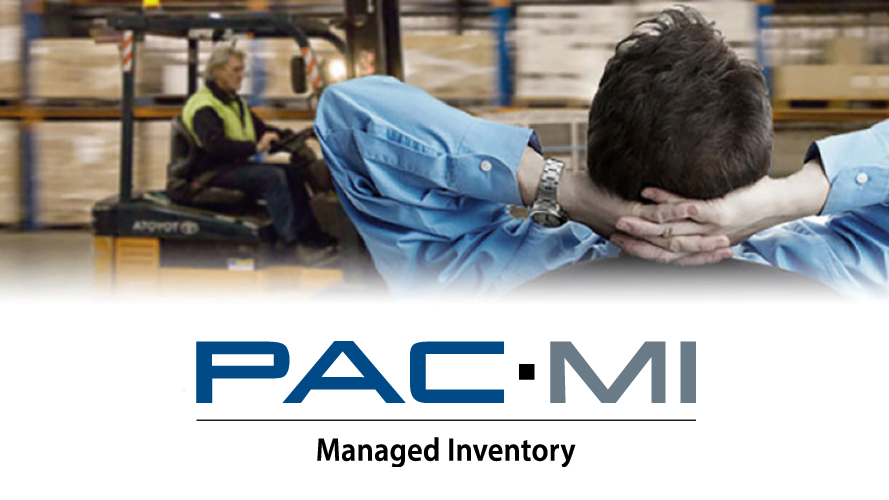Whether your manufacturing facility has a handful of engineers or hundreds of operatives working in multiple locations, you might wonder about the best strategy to manage your consumable logistics. Vendor Management Inventory (VMI) is an inventory administration practice where a supplier—usually the manufacturer—optimizes the inventory held by a distributor. The right VMI solution will help save cost and time and ensure a healthy supply of materials so that they are always readily available.
Tailoring a Vendor Management Inventory Program
One can tailor VMI programs to fit specific manufacturing needs. When tailoring a VMI solution, it’s important to consider usage rates, available on-site storage, product lead times, and pricing.
In its most basic form, a VMI program may be a list of crucial stocked items that are readily available for purchase and shipment. A more complex VMI strategy can include inbound and outbound monitoring down to individual products received into inventory.
To ensure your manufacturing space has the products andmaterials readily available to fit your needs, it’s important to know some of the available VMI programse, along with their customer and vendor responsibilities.
Types of Vendor Management Inventory Programs
Stocking Agreement
A stocking agreement is the most basic type of VMI program. It involves identifying critical items and their usage rates to set a shipment of products in a set interval or upon request.
For example, a customer could list 4 or 5 items that are critical to their operation—such as sterile IPAwipersr, chemical cleaners, or a certain type of swab—and set a usage level. The agreement would set in motion a reserved level of inventory that is always set aside for purchase by the customer, with releases set automatically or as needed. On the vendor side, the vendor maintains the agreed stocking levels, offering customers a hands-off purchasing and inventory maintenance experience. In a stocking agreement, typically the consumer purchases any outstanding inventory if usage levels for an item are reduced or eliminated. This is especially true for items with a shelf life or items that would not otherwise be stocked.
Blanket Purchase Order (PO)
Similarly, to a stocking agreement, a blanket PO sets in motion a vendor-managed purchase of critical items. These items are held in a reserved inventory and shipped at set intervals. Blanket POs will often come with a pricing agreement instead of holding inventory susceptible to market conditions. Customers who know their usage rates and purchase months’ worth of inventory at a time use blanket POs. Final costs are only realized when products are shipped and received.
Consignment Inventory
Rather than the vendor warehousing the products, the consumer holds the inventory on-site. Item invoices only deploy when the customer uses inventory. Vending machines, tool cages/cribs, and tool cabinets are common examples of this type of VMI program. Blanket POs, or software that automatically tracks the dispensing of items, often assist with purchasing. Cycle counts are also a common way to keep track of the remaining inventory and account for all items used, and refilling needs.
On-Site Managed Inventory
This type of program involves a blanket PO. A vendor representative with access to the facility is to perform a weekly, bi-weekly, or monthly inventory count. The software tracks inventory levels. These levels are then spread to multiple customer contacts. and categorized into distinct physical stocking locations. For example, distinct locations can be changing room storage areas, facilities’ storerooms, or designated spaces in a warehouse.
The reliability of the quantity-level data in this type of program depends on the frequency of counts. On-site personnel can scan out products as they use them rather than relying on routine counts. Once the quantity dips below a set threshold, the system automatically triggers a release of this product from the warehouse. There is an option of batching several items together for periodic release.
This approach helps save on shipping, receipt, and restocking costs. Another major benefit of on-site managed inventories is the availability of historical data. This can help to identify trends in the reduction or increase of item usage. This data can adjust inventory levels purchased into reserved inventory and remain ahead of potential gaps in product availability. Since the reserved inventory depends on the vendor, customers are relieved from managing the purchasing alone. This type of VMI program increases efficiency on both ends, allowing shared cost savings.
Hybrid Customer/VMI Programs
Just like on-site VMI programs, this option identifies on-site users who can scan inventory in and out, as well as restocking shelves, and receive inventory when an auto-replenishment of goods occurs. Vendors perform inventory counts to ensure accountability and to help maintain proper inventory levels based on storage space and usage rates.
VMI Programs with Dedicated Personnel
Taking the hybrid programs a step further, VMI programs with dedicated personnel are an all-inclusive type of management. A vendor representative would remain on-site full- or part-time to oversee all aspects of the program. Routine counts, reporting and receiving replenishments, and restocking products are some tasks that a full-time vendor representative would take care of.
To implement this type of VMI program, a vendor representative performs a site study. The representative shadows the customer’s team and identifies their considerations, such as safety requirements for chemical handling or forklift operations, requirements for product replenishment and monitoring, or special access and employee requirements like military and sensitive operation training. These programs improve the efficiency and continuity of VMI products by closely monitoring inventory by an outside source. Customers get the advantages of remote monitoring, real-time inventory views, and the setup of a cost center for products that can be tracked at a smaller scale.
Why Use PAC Managed Inventory?
The correct VMI program can help ease costs and time and ensure inventory levels fit the needs of your manufacturing operation. No matter the scale, PAC has helped many customers navigate what solutions will best fit their needs. PAC Managed Inventory has you covered with a fully-featured solution that can satisfy the requirements of several types of inventory management programs, including: Inventory Control, Vendor Managed Inventory, Replenishment Programs, and Inventory Consignment.
Save Time, Reduce Costs, and Eliminate Stock outs with Intuitive Software. So, ready to take the next step? Start here.
Related Posts
-
Carbon Dioxide: Dangers & Management
Carbon dioxide becomes dangerous to people and animals when it begins to displace oxygen. An asphyxiant gas is a nontoxic (in the case of carbon dioxide) gas which reduces or displaces the oxygen concentration in…
-
Kimberly-Clark Professional™ PPE, Garments, and Recycling Program (RightCycle)
Demand for eco-sensitive products and zero-waste initiatives has never been more pronounced. When you purchase Kimtech and KleenGuard products from Production Automation (PAC), you get the benefit of RightCycle by Kimberly-Clark Professional. This program delivers…
-
Training and Compliance Verification Auditing: The Fundamentals of Electrostatic Discharge, Part 4
This copyrighted information is licensed for reproduction by EOS/ESD Association, Inc. Click here to view the original article. Your static control program is up and running. How do you determine whether it is effective? How do you…
-
Press: PAC Expands to New XL Warehouse
The new Production Automation Corporation (PAC) HQ provides over 10X more floor space with 3X more vertical capacity. Located in Minnetonka, we're now just a hop and skip away from many of our medical device…
-
New: Texwipe Cleanroom Products
Texwipe offers a variety of dry, pre-saturated, and sterile wipes to meet the strict demands of controlled environments. Texwipe swabs are manufactured to exacting and consistent tolerances with lot coded for traceability and quality control.
-
Carbon Dioxide: Dangers & Management
Carbon dioxide becomes dangerous to people and animals when it begins to displace oxygen. An asphyxiant gas is a nontoxic (in the case of carbon dioxide) gas which reduces or displaces the oxygen concentration in…










